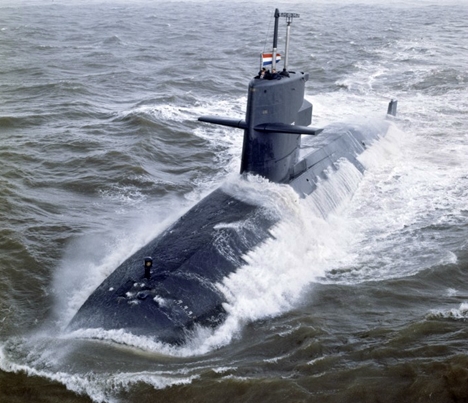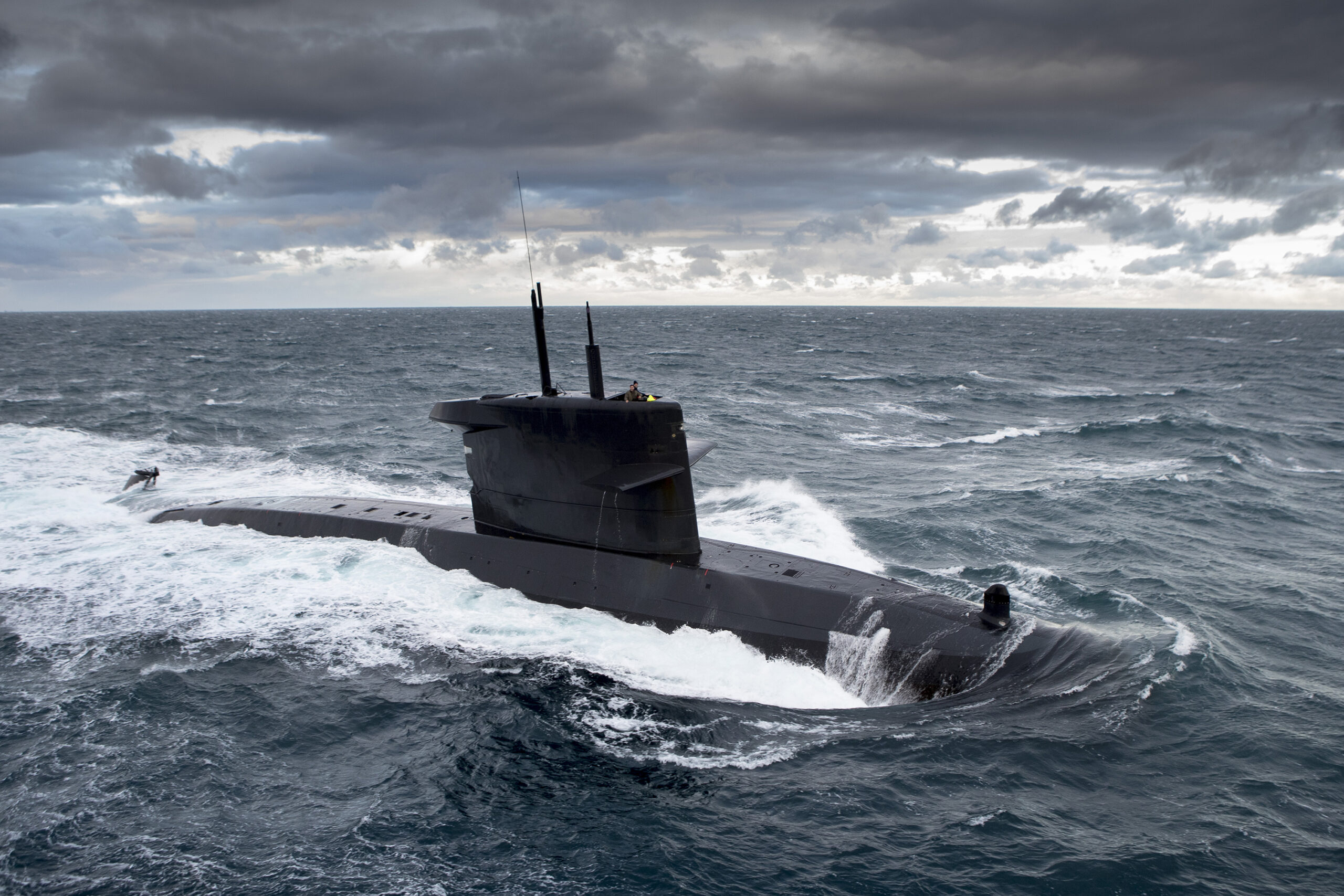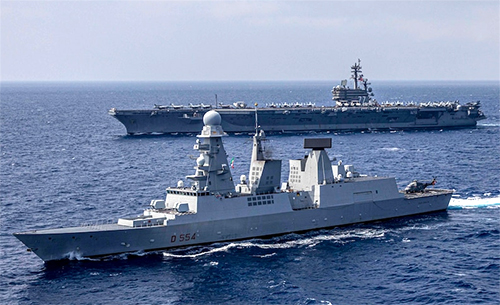Unmanned anti-submarine warfare, ‘we can’t escape it’
Complementing drones that will hunt for mines, the Royal Netherlands Navy and the Belgian Navy will also get unmanned vessels in the near future that will hunt for submarines. One of the possible unmanned anti-submarine warfare vessels is the Seagull, offered by the Israeli company Elbit. This vessel can carry sonars and torpedoes, just like a helicopter which is one of the submarines’ greatest enemies, however it can search for 4 days instead of 4 hours. The future of anti-submarine warfare (ASW) is unmanned.
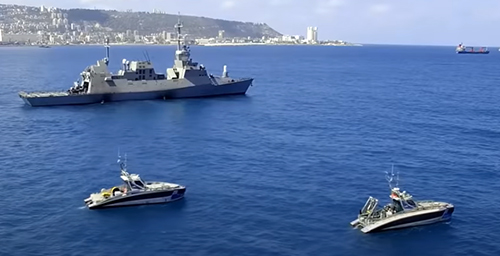
Two Seagulls from Elbit next to an Israeli Sa’ar 5 class corvette. The Seagull has been designed as an unmanned surface vehicle and built by De Haas in the Netherlands. Both Seagulls on the picture can be manned, this is due to regulations in Israel. (Picture: Elbit)
In about eight years from now, the replacement of the current M-class frigate must be delivered. These four frigates for Belgium and the Netherlands are optimised for ASW; they will be quieter, are equipped with special sonars and torpedoes, but surface ships are and will remain at a disadvantage when confronted by a hostile submarine. That is why specialised anti-submarine warfare helicopters have been operating from these frigates for decades.
Future Dutch and Belgian frigates will, next to helicopters, be provided with unmanned surface vessels. The first model that was shown in 2013 already showed the capability to carry 12-metre long unmanned surface vessels (USVs). USVs have therefore been part of the philosophy of the new frigates from the start.
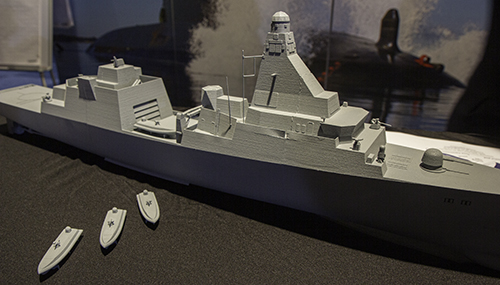
USVs have been part of the plan for the future Dutch and Belgian frigates from the beginning. The first model, here in 2013, had, apart from two cranes and an open deck, no facilities for the USVs, but these boats were 12 meters long. (Photo: Jaime Karremann / Marineschepen.nl)
The Israeli company Elbit is one of the possible suppliers of such USVs. That’s why I have been speaking to retired rear admiral Yaron Levi, vice president of Elbit Naval Systems. We first met in 2018 during Euronaval, when Elbit with Dutch shipbuilder Damen were still in the competition to supply the new mine countermeasures capability for Belgium and the Netherlands.
As is known, the latter assignment went to Naval Group and ECA.
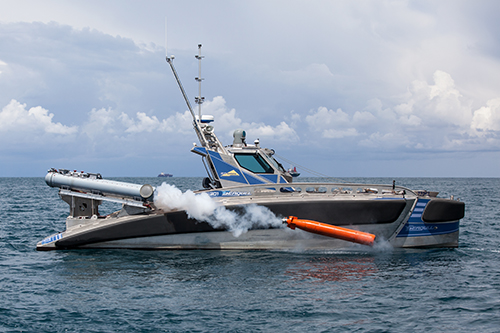
A Seagull fires a lightweight torpedo. (Photo: Elbit)
Fighting submarines
However, the Seagull is not a one trick pony, the 12-metre long unmanned vessel is suitable to execute multiple tasks: mine countermeasures, force protection, intelligence gathering and fighting submarines. And in the latter role, the USV could also operate from the future Belgian and Dutch frigates.
“The Seagull has roughly the same sensors and weapon systems as a helicopter,” says Levi. “But a helicopter can stay airborne for three or four hours. The Seagull can search for submarines for four days.”
In the concept developed by Elbit, typically two USVs hunt for the submarine together. It is possible to have one USV as a hunter-killer, which will have to be equipped with both sonar and torpedoes, but that is not preferred. It is better to set up one Seagull as a hunter and one as a killer.
The Seagull as a hunter can then be equipped with various systems, such as a dipping sonar. Levi: “We use the HELRAS from L3, but any dipping sonar can be integrated. We have open architecture that enables us to integrate any type of dipping sonar such as Thales’ Flash.” The Dutch NH-90 helicopters are also equipped with HELRAS, one of the best helicopter sonars available.
The Seagull can also be equipped with sono buoys, these kind of buoys normally are dropped into the sea by helicopters and airplanes and can actively or passively search for submarines.
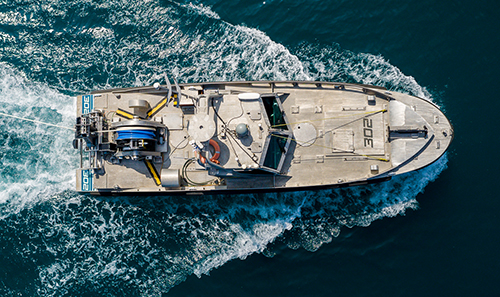
Towed Reelable Active Passive Sonar (TRAPS) during trials. (Picture: Elbit)
It does not stop there if it is up to Elbit. “We have also developed TRAPS, a special active passive towed sonar together with our Canadian subsidiary Geospectrum Technologies:,” says Levi. Active-passive towed sonars are more and more important for ASW-frigates and will turn a USV into a truly formidable asset.
“With such a sensor you can search for submarines while on the move, for the dipping sonar you have to be stationary”, Levi explains. “We tested the towed sonar near Haifa and the results were excellent. The Seagull is the only USV in the world with a towed sonar. ”
In addition to underwater sensors, the Seagull can also carry Electronic Warfare equipment, electro optic sensors, radar and more.
The killer configured Seagull can be equipped with lightweight torpedoes.
Together the USVs search autonomously for the lurking submarine. “You just have to indicate their search area and then they get to work. The USVs are familiar with the right of way rules at sea. Human consent is required if the USV proposes firing a torpedo or any other type of weapon,” says Levi. “The Seagull can be completely autonomous and learn from missions, while benefitting from ‘supervised autonomy’ by humans.”
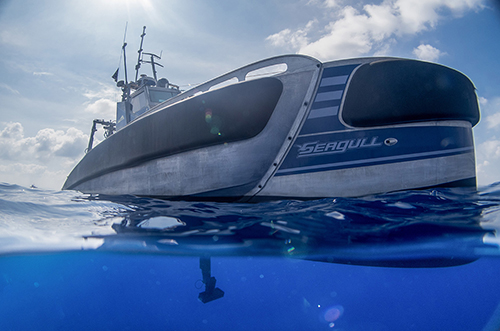
The Seagull has a draught of 80 centimeters. On this picture the retractable forward looking sonar/ multi-beam echo sounder can be seen, lower than the keel. (Picture: Elbit)
No target
USVs are becoming increasingly dangerous for submarines, but are not easy to eliminate for nowadays submarines.
Despite all the possibilities offered by a USV, the costs are relatively low, according to Levi. “At least a fraction of a ASW-corvette or frigate with a crew of at least one-hundred,” he says. The Seagull is said to amount to 5% of the cost of an anti-submarine warfare corvette.
“Suppose a submarine commander feels so threatened that he decides to take out the Seagull,” says Levi. “Then he has to launch a $ 5 million torpedo on an aluminum boat. A tough decision. Suppose he does … 99 percent of the torpedoes will not be able to take out the Seagull. The Seagull is not only made of aluminum [torpedoes explode under a ship and are triggered by magnetism, JK], the Seagull’s draft is a mere 80 centimetres.”
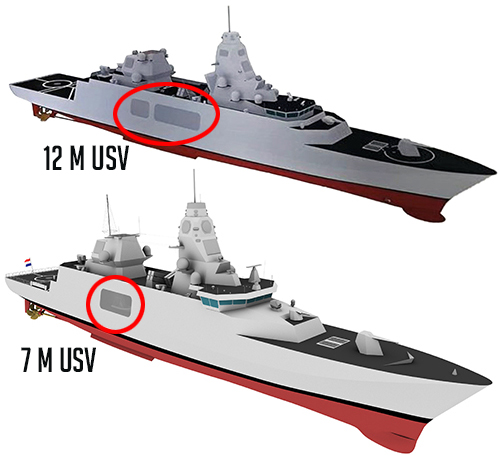
The larger future frigate concept (2019) including room for 12 meter USVs was too expensive and after a modification, there is only room for a 7 meter USV. (Photos: DMO, edited by Jaime Karremann)
Too bad, it won’t fit
For those of you who based on all this see a bright future for the Seagull on board the new Dutch and Belgian frigates, there is some bad news: the Seagull will not fit.
The RMF-22D frigate that the Dutch Defence Materiel Organisation (DMO) had designed for Belgium and the Netherlands was considered too expensive. Changes were made to the design last spring. In general, these were not major changes, however one change has major consequences: the maximum size for USVs was reduced from 12 meters to 7 meters.
The Seagull is 12 meters.
What does that mean for Elbit? “The Seagull was designed in the Netherlands and is being built by De Haas in Maassluis,” says Levi. “We can adapt the design and we work closely with De Haas. For another potential customer we have to make a version of 18 meters. We can also develop a USV of 7 metres.”
Does it matter? Maybe not so much for Elbit, for the possibilities of the USV it matters though. “There is always tension between size and capabilities. A larger USV can do more: it can be equipped with sonar and torpedo (7 meters USV has room for either a sonar or a torpedo), can carry towed sonar (7 meters USV: still to be researched and developed if possible), the larger USV can sail in higher sea states and has greater range. On the other hand, you can more of the smaller USVs, assuming you have adequate space of course.
“The Dutch navy is a leading navy in the field of anti-submarine warfare,” says Levi. “If you look at the developments, you see that anti-submarine warfare is moving in the same direction as MCM: more unmanned cpability. And then, with the utmost humility, I would suggest freeing up more room for a capable USV. Although you can also do some activities with a 7-metre USV.”

Seagull integrated in the MCM concept of Damen. (Picture: Damen)
“Learned a lot from cooperating with Damen”
Although Elbit has not yet worked on much of the Dutch navy’s equipment, the company is in fact very familiar with Dutch industry. “During the tender for mine countermeasures we got to know Dutch organizations. We have spoken to research institute TNO several times, but also to DMO and the navy,” says Levi. “And I can tell you that we spent a lot of time with Damen integrating USVs on board MCM vessels, as well as frigates.”
According to Levi, there are, very broadly, three features that are important in order to be able to operate with USVs:
- the frigate must have a launch and recovery system (LARS) suited for unmanned vessels (in a manned RHIB a crew member can attach a hook from a crane to the RHIB)
- space to accommodate several USVs (preferably inside)
- room for storage of sonars, torpedoes, etc.
- space to maintain the USVs / change modules, etc.
The USVs have to be integrated into the command center’s software, however that is not different from integrating a radar or a weapon system on board the frigate.
Also in terms of communication, a USV has no major impact, according to Levi. Basically, the standard ship’s communication systems are sufficient.
Over the horizon
The Seagull is designed to conduct ASW independently over the horizon. Of course contact between the frigate’s Opsroom and the USV is maintained at all times. As soon as the USV operates beyond line of sight, communication goes via satellite. Levi: “Then distance doesn’t matter anymore. We gave demonstrations during trade shows where we controlled a Seagull in London, from Israel. And we did that too with a Seagull demonstrating its capabilities in Singapore and Sydney.”
Wherever the Seagull might be, the Opsroom is provided with a real-time picture of what is happening beneath the waves. It is also possible to operate with the Seagull from a container on deck of an LPD or tanker.
Operating with USVs over the horizon in a hostile will mean that an enemy will try to jam the communications between the ship and unmanned vessel. “Together with our sister division of Elbit, specialised in Electronic Warfare, we offer solutions that make the Seagull resistant to jammers,” explains the former Navy officer. “The Seagull can also function if GPS suddenly fails or is unreliable, that is part of the ‘safety & collision avoidance’ algorithm.”
There are also various backup communication methods. In the unlikely event that communication is no longer possible at all, the USV will recover all sonars and return to a predetermined point.
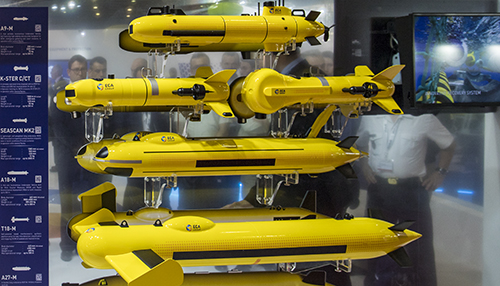
The complete toolbox for the future Dutch and Belgian mine countermeasure vessels is designed and built by ECA Group. (Picture: Jaime Karremmann/ Marineschepen.nl)
Cooperation with competitors?
A Seagull can be converted by the crew of a frigate in about three hours from ASW to MCM and vice versa.
Elbit has not only devoted a lot of time to the Seagull as a submarine hunter in recent years. Together with Hydroid, underwater drones and mine sweeping systems have been developed that can be used by the Seagull. Levi shows the results of the trials that the companies taking part in the tender for the mine countermeasures vessels for Belgium and the Netherlands conducted in the North Sea in 2017. Elbit participated with the Seagull. Levi: “We found 33 out of 35 mines and got the highest score of all participants.”
Despite these results, the Belgian and Dutch navies will soon have ECA USVs and associated tools. Could these tools also be used on board the Elbit’s USV if these navies want to use the Seagull for mine countermeasures? Levi: “That could be done, the design can be adapted and we can work together with ECA. We have done that before and if the customer wants that, we can do it. If the anti-submarine warfare USV will be 12 meters, just like that of ECA, it is more likely that we can use the same toolbox as much as possible. If the USV becomes 7 meters, we will have to look for solutions that fit.”
Future
As promising as unmanned hunting of submarines may sound, few navies have taken actual steps in this regard. According to Elbit, several countries are interested in the Seagull. “We have a contract with the Israeli Navy for some time now and there is a lot of interest. I think you will soon be hearing positive news about the purchase of the Seagull from one of the countries that is interested. However,” admits Levi, “we expected things to go faster.”
Why are many navies reluctant? Levi: “The technology is ready, that’s not the problem. We can do a lot with USVs. The reasons why navies have not yet embraced USVs are mainly psychological and sociological reasons. In the air domain, things go much faster when it comes to unmanned technology. Perhaps it is because humans have been sailing for thousands of years and developments in the air only started 150 years ago.”
Still, Levi remains a firm believer in an unmanned future: “The Seagull is not the solution to everything, but at a time when trillions of dollars are being pumped into ships and helicopters to hunt submarines, USVs that cost a fraction of the price and which require no people, become more and more attractive. USVs are ideally suited for a range of tasks, from the dullest to the most dangerous of jobs. As such it is a true “force multiplier”. It will take some time, but the unmanned hunting of submarines is about to happen. We can’t escape it.”
This article first appeared on 20th of October 2020 in Dutch on Marineschepen.nl. This is a sponsored article. With a sponsored article, a client chooses the subject of the article. Elbit paid Marineschepen.nl to write this article on this topic, but Elbit had no influence on the journalistic content.

